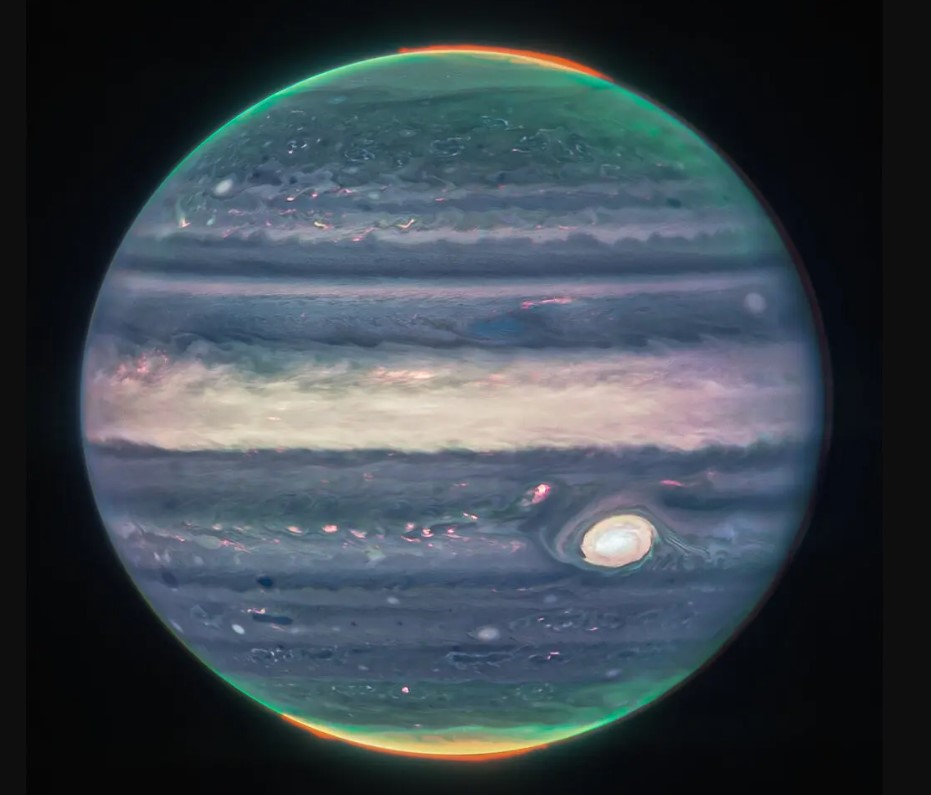Now that’s an image. It’s been getting some attention, and for good reason. Marvel of the age. Posted here.
The entire caption, for form’s sake, since I’m not going to further investigate the technical specs of the filters:
Webb NIRCam composite image of Jupiter from three filters – F360M (red), F212N (yellow-green), and F150W2 (cyan) – and alignment due to the planet’s rotation. Credit: NASA, ESA, CSA, Jupiter ERS Team; image processing by Judy Schmidt.
I saw a video clip about these Webb images today — produced by some local news outfit — and Jupiter was called “fifth rock from the sun.” Had a nit to pick with that, right away. Pretty big nit, actually, consider that Jupiter’s equatorial diameter is about 88,900 miles. The planet isn’t called a gas giant for nothing.
The following are couple of physical leftovers from the Michigan trip, acquired at grocery stores along the way. In both cases, my friends left the unused portion behind with us, and we’ve used them up in the weeks since. Such as the ground coffee. They said it was good, and Yuriko agrees.
Superior Coffee Roasting Co. is in Sault Ste. Marie, state of Michigan side.
The coffee bag got me thinking. Just how many ore carriers are their plying the Great Lakes these days? The Great Lakes Shipwreck Museum didn’t mention that, or at least that I saw. But the answer isn’t hard to find in our Internet-linked times.
More than 100 freighters transport iron ore across the Great Lakes, a combination of U.S.- and Canadian-flagged, and international carriers, according to an article published by the Great Lakes Seaway Partnership in 2019.
Citing the Iron Mining Association of Minnesota, the article also notes “more than 80 percent of the nation’s iron is mined in Minnesota, and that ore accounts for nearly 60 percent of shipments leaving the Duluth port. Iron ore led the port’s exports in the last year [2018], with 21.5 million tons shipped — the most transported from Duluth-Superior in a single season since 1995.”
Next, strawberry-rhubarb jam. Gone, as you can see. Much of it put on my breakfast breads this month. Wonderful sweetness. From Keweenaw Kitchens of Baraga, Michigan, on L’Anse Bay on Lake Superior.
Good travel writing can be hard to find. I came across this text the other day, when looking for useful information about a particular small U.S. city, Z.
Are you ready to explore some of the most AMAZING things to do in Z?
All caps doesn’t inspire confidence, but let’s carry on.
The perfect blend of unrivaled nature and diverse culture, Z is one of [state name]’s most vibrant and eclectic towns.
Interesting choice of adjective to go with “nature”: unrivaled. I’ve never been to this city, but I’m sure its “nature” is interesting enough, maybe even beautiful. Much else surely rivals it, though.
As a buzzing college town, Z offers an abundance of events and activities as well as being the perfect melting pot of different states from across America.
The only bit of useful information in that sentence is the fact that Z is a college town; but I already knew that, and so do many other people.
Not only is Z a hive of activity and excitement, the town also offers some of the most spectacular nature to be found in [state name].
This unique town is one not to be missed and with so many things to do in Z, you will certainly want to stop by.
“I’m looking for the hive of activity and excitement,” you say to the clerk at the Information booth in Z’s airport. “Could you tell me where that is?”
Well, it’s easy to mock this paint-by-numbers intro, but I might go through the slide show anyway, despite the fact that I’d support this kind of bad writing in some small way by adding to its clicks. Why? You can learn even from bad sites. I don’t know the city that well, so I’m bound to notice someplace I might want to see.
Sure enough, I did. More than one place.